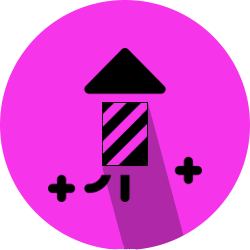Fireworks-related injuries: data blog:
Summary of statistics highlighting injuries associated with fireworks and other related products.
- Last updated: 2023-06-29
Fireworks and other pyrotechnic products have gained much popularity in Canada. With their impressive auditory and visual effects, it is not surprising that such products play important roles in celebrating special events. From the Inuvik Sunrise Festival in the Northwest Territories to the Canada Day celebrations occurring in many regions across Canada, such displays attract and amaze large crowds. However, when proper safety precautions are not taken, injuries can occur placing the health of individuals at risk.
Presented below are statistics highlighting injuries associated with fireworks and other related products, such as sparklers and firecrackers, reported between April 1, 2011 and April 13, 2023 in the Canadian Hospitals Injury Reporting and Prevention Program (CHIRPP) database.
For information on fireworks safety, please see this fireworks safety video.

How many cases were there?
Between April 1, 2011 and April 13, 2023, there were 210 reported cases of injuries related to fireworks and other similar products, representing 11 cases per 100,000 CHIRPP records.
Age groups
Young adults between the ages of 20 and 29 years represented the largest proportion at 22 cases per 100,000 CHIRPP records but were closely followed by those aged of 30 and 39 years, who represented 18 cases per 100,000 CHIRPP records.
Males vs. females
Overall, 67.1% of the patients injured were male (n = 141).

Days of the week injury occurred
Over half of all injuries (57.1%) occurred on a Saturday, Sunday or Monday.
Time of year during which injury occurred
Approximately two-thirds of all injuries (66.2%) occurred between May and August. Nearly a third of all injuries (29.0%; n = 61) occurred on days surrounding Victoria Day (May 16 to 24) and Canada Day (June 29 to July 3).

Most common injuries
The most common type of injuries were burns, representing 61.0% of cases (n = 128), followed by eye injuries at 19.1% (n = 40). Of the 128 burns, the most affected body region was the upper extremity region (hands, fingers and forearms), which represented 55.5% of such cases (n = 71). The head and neck region then followed, representing 25.0% of burns (n = 32). Thirty-eight individuals (18.1%) sustained burns in multiple body regions.
What level of in-hospital treatment was needed?
Nearly three-quarters of all cases (73.8%) required medical treatments in the emergency departments, and 11.4% of patients were admitted to hospitals.
Take note
CHIRPP is an injury and poisoning sentinel surveillance system operating in the emergency departments of 11 paediatric and 10 general hospitals across Canada. Since its inception in 1990, this database has colected over 4.2 million records, making it an important resource for information on injuries and moving forward programs and policies that aim at reducing and preventing injuries among Canadians. Learn more about the Canadian Hospitals Injury Reporting and Prevention Program.
Data extraction was conducted using English and French key word searches in the patients’ narratives of the injury event and examining factor codes pertaining to injuries concerning fireworks and other related products.
The results presented above should be interpreted with caution as they do not represent all injuries related to fireworks and other similar products in Canada. CHIRPP is a sentinel surveillance system and collects data from select emergency departments across Canada. Injuries involving Indigenous peoples including Inuit, Métis and First Nations and people who live in rural areas may be under-represented in the CHIRPP database, as most CHIRPP hospital sites are located in major cities. Fatal injuries are also under-represented in the CHIRPP database as the emergency department data do not capture deaths occurring before being taken to the hospital or after being admitted via another department. Information is continuously entered into the CHIRPP database; therefore, some years do not yet have complete data.
You might also be interested in
Injuries related to barbecue brush bristle ingestion/inhalation
Analysis of such injuries.
Drowning related deaths and injuries
Statistics highlighting drownings.
- Date modified:


